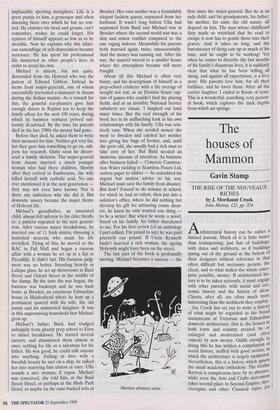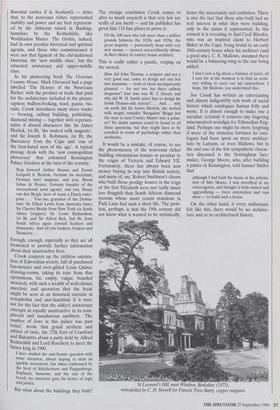The houses of Mammon
Gavin Stamp
THE RISE OF THE NOUVEAUX RICHES by J. Mordaunt Crook John Murray, £25, pp. 354 Architectural history can be rather a limited pursuit. Much of it is little better than trainspotting: just lists of buildings, with dates and architects, as if buildings spring out of the ground at the behest of their designers without reference to that often difficult but necessary person, the client, and to what makes the whole enter- prise possible, money. If architectural his- tory is to be taken seriously, it must engage with other pursuits, with social and eco- nomic history and the history of ideas. Clients, after all, are often much more interesting than the architects they employ. Joe Crook has set out to write a history of what might be regarded as the broad mainstream of Victorian and Edwardian domestic architecture, that is, the houses in both town and country created by or enlarged and modernised (and often by new money. Oddly enough, in doing this he has written a compilation of social history, stuffed with good stories, in which the architecture is largely incidental. Nevertheless, this is a history which upsets the usual academic orthodoxy. The Gothic Revival is conspicuous here by its absence, while even the Arts and Crafts movement takes second place to Second Empire, rien" Georgian and other Classical styles (or Baronial castles if in Scotland) — styles that, to the nouveaux riches, represented stability and power and are best represent- ed by the châteaux raised in Bucking- hamshire by the Rothschilds, like Waddesdon Manor. The Gothic, indeed, had its own peculiar historical and spiritual agenda, and those who commissioned it were not that figment of the old-fashioned historian, the 'new middle class', but the educated aristocracy and upper-middle class.
In his pioneering book The Victorian Country House, Mark Girouard had a page labelled 'The Houses of the Nouveaux Riches' with the product or trade that paid for the architecture included in the picture caption: bullion-broking, wool, guano, bis- cuits. Crook introduces many more trades — brewing, railway building, publishing, diamond mining — together with represen- tative if absurd characters like Sir James Horlick, 1st Bt, 'the malted milk magnate', and Sir Joseph B. Robinson, 1st Bt, the Buccaneer from the Cape and 'one of the best-hated men of the age'. A typical passage deals with the 'new cosmopolitan plutocracy' that colonised Kensington Palace Gardens at the turn of the century:
Step forward Arthur Strauss and Ernest Leopold S. Benzon, German tin merchant, German steel magnate; and you, Baron Julius de Reuter, German founder of the international news agency; and you, Henry van den Bergh, hero of many a Dutch enter- prise . . . You too, grandees of the Domin- ions: Sir Elliott Lewis from Australia (law); Sir Chester Beatty from New York via South Africa (copper); Sir Lewis Richardson, 1st Bt, and Sir Alfred Beit, 2nd Bt, from South Africa again (ostrich feathers and diamonds). And all you bankers, brokers and financiers .
Enough, enough, especially as they are all footnoted to provide further information about their unattractive lives.
Crook conjures up the ruthless ostenta- tion of Edwardian society, full of purchased baronetcies and over-gilded Louis Quinze drawing-rooms, taking its tone from that eponymous, fat, empty, vulgar, bearded monarch, with such a wealth of well-chosen anecdote and quotation that the book might be seen as an historical exercise in xenophobia and anti-Semitism if it were not for the fact that the old(er) aristocracy emerges as equally unattractive in its com- placent and mendacious snobbery. 'The number of Jews in this palace was past belief,' wrote that grand aesthete and arbiter of taste, the 27th Earl of Crawford and Balcarres about a party held by Alfred Rothschild and Lord Rosebery to meet the future king in 1900.
I have studied the anti-Semite question with some attention, always hoping to stem an ignoble movement; but when confronted by the herd of Ickleheimers and Puppenbergs, Raphaels, Sassoons, and the rest of the breed, my emotions gain the better of logic and justice.
But what about the buildings they built? The strange conclusion Crook comes to after so much research is that very few are really of any merit — and his publisher has given him 118 fine plates to prove it.
Of the 200 men who left more than a million pounds between the 1820s and 1920s, the great majority — particularly those with very new money — proved extraordinarily obtuse in their choice of country house architect.
This is really rather a puzzle, verging on the surreal.
How did John Thomas, a sculptor and not a very good one, come to design not one but two mansions — both of them incompetently planned — for not two but three railway magnates? Just who was W. J. Green, and why did W. H. Smith select him to design his lavish Thames-side retreat?. . . And . . . why on earth did Sir James Horlick, the malted milk mogul, consider `Bungalow' Briggs just the man to turn Cowley Manor into a palaz- zo? No doubt answers could be found to all these questions; but they might have to be couched in terms of psychology rather than aesthetics.
It would be a mistake, of course, to see the phenomenon of the nouveaux riches building ostentatious houses as peculiar to the reigns of Victoria and Edward VII. Fortunately, there has always been new money buying its way into British society, and many of, say, Robert Smithson's clients who built those prodigy houses in the reign of the first Elizabeth were not really much less thuggish than South African diamond tycoons whose more recent mansions in Park Lane had such a short life. The prob- lem, perhaps, is that the 19th century did not know what it wanted to be stylistically, hence the uncertainty and confusion. There is also the fact that those who built had no real interest in what they were building, only in the status it represented. In this context it is revealing to find Cecil Rhodes, who was an inspired client to Herbert Baker at the Cape, being brutal to an early 18th-century house when his architect (and a good one), C. E. Mallows, assumed there would be a balancing wing to the one being added: I don't care a fig about a balance of parts; all I care for at the moment is to find an archi- tect willing to carry out my instructions. I hope, Mr Mallows, you understand this.
Joe Crook has written an entertaining and almost indigestibly rich work of social history which catalogues human folly and waste. It is almost enough to make one a socialist; certainly it removes any lingering misconceived nostalgia for Edwardian Eng- land. Perhaps one might be more forgiving if more of the immense fortunes he cata- logues had been spent on more architec- ture by Lutyens, or even Mallows, but in the end one of the few sympathetic charac- ters discussed is the Nottingham lace- maker, George Moore, who, after building a palace in Kensington, told Samuel Smiles that
although I had built the house at the solicita- tion of Mrs Moore, I was mortified at my extravagance, and thought it both wicked and aggrandizing — mere ostentation and vain show — to build such a house.
On the other hand, if every millionaire felt like this, there would be no architec- ture and so no architectural history.
St Leonard's Hill, near Windsor, Berkshire (1875), remodelled by C. H. Howell for Francis Tress Barry, copper magnate.



























































































 Previous page
Previous page